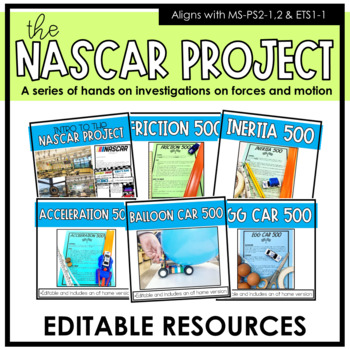The NASCAR Project: Forces & Motion
- Zip
What educators are saying
Products in this Bundle (6)
showing 1-5 of 6 products
Description
Description:
Are you teaching your students about forces and motion? If so, the NASCAR Project is my FAVORITE way to teach my students about those concepts! Students complete a series of NASCAR-themed races/investigations to learn about Newton's laws of motion, inertia, acceleration, collisions, and practice their science and engineering skills! All the resources in this bundle are designed for in-person and at-home learning plus everything is editable.
What's Included:
- Intro to the NASCAR Project (includes room transformation details and timeline of how I teach this project in my own classroom)
- FRICTION 500
- INERTIA 500
- ACCELERATION 500
- BALLOON CAR 500
- EGG CAR 500
Supplies Needed (per group):
1. One Hot Wheel car
2. Ramp (hot wheel tracks or I used 5 meter sticks taped together)
3. Books/Bins to prop up the ramp
4. Masking tape or binder clip to attach surfaces to the ramp.
5. Different surfaces that can be cut into one-meter strips to create different amounts of friction (felt, burlap, vinyl, satin, wax paper, sandpaper, etc.). I just grab different fabrics with different textures from Walmart.
6. Calculators
7. Timer (we use an online timer from Google on student Chromebooks)
8. Tape measure
9. 3 x 2 x 2 cm piece of Play-Doh
10. Two pencils
11. Tape
12. Hot Wheel car launcher or plastic straw
13. 2-3 five-inch balloons
14. One raw egg
15. One plastic Easter egg
16. Small Ziplock bag
17. Household items that students can use to protect their egg (cardboard, toilet paper, paper towels, popsicle sticks, cotton balls, etc.)
18. Ramp (Anything to make a large ramp with. I use two large pieces of white hardboard from Home Depot and place them on top of two folding tables.)
19. A wall, cement blocks, or something hard for the egg cars to crash into
Optional: digital scale, Hot Wheel tracks if you will be using Hot Wheel launchers
How I Like to Use This Product:
This is how I teach my students about forces and motion. I love taking a project-based approach to science because students are easily engaged, excited about science, and everything is applicable to real life! I use these races/investigations to enhance our district curriculum. This is always my students and I's favorite project of the year!
Thank you for visiting my store! I am SO honored you are here! Being able to share ideas with other teachers brings me great joy! If you like this product, please leave a review or share a picture on Instagram of this product in your classroom! Don’t forget to tag @mrsnelsonsmiddles!


